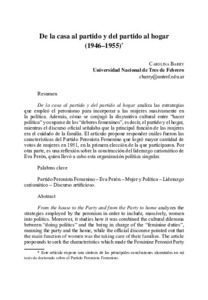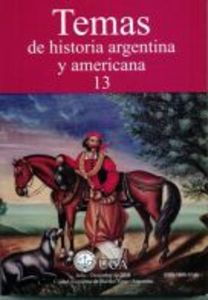Por favor, use este identificador para citar o enlazar este ítem:
https://repositorio.uca.edu.ar/handle/123456789/16128| Campo DC | Valor | Lengua/Idioma |
|---|---|---|
| dc.contributor.author | Barry, Carolina | es |
| dc.coverage.spatial | Argentina | es |
| dc.coverage.temporal | SIGLO XX | es |
| dc.date.accessioned | 2023-04-04T10:36:38Z | - |
| dc.date.available | 2023-04-04T10:36:38Z | - |
| dc.date.issued | 2008 | - |
| dc.identifier.citation | Barry, C. De la casa al partido y del partido al hogar (1946–1955) [en línea]. Temas de historia argentina y americana. 2008, 13. Disponible en: https://repositorio.uca.edu.ar/handle/123456789/16128 | es |
| dc.identifier.issn | 1666-8146 | - |
| dc.identifier.issn | 2618-1924 (online) | - |
| dc.identifier.uri | https://repositorio.uca.edu.ar/handle/123456789/16128 | - |
| dc.description.abstract | Resumen: De la casa al partido y del partido al hogar analiza las estrategias que empleó el peronismo para incorporar a las mujeres masivamente en la política. Además, cómo se conjugó la disyuntiva cultural entre “hacer política” y ocuparse de los “deberes femeninos”, es decir, el partido y el hogar, mientras el discurso oficial señalaba que la principal función de las mujeres era el cuidado de la familia. El artículo propone responder cuáles fueron las características del Partido Peronista Femenino que logró mayor cantidad de votos de mujeres en 1951, en la primera elección de la que participaron. Por otra parte, es una reflexión sobre la construcción del liderazgo carismático de Eva Perón, quien llevó a cabo esta organización política singular. | es |
| dc.description.abstract | Abstract: From the house to the Party and from the Party to home analyzes the strategies employed by the peronism in order to include, massively, women into politics. Moreover, it studies how it was combined the cultural dilemma between “doing politics” and the being in charge of the “feminine duties”, meaning the party and the home, while the official discourse pointed out that the main function of women was the taking care of their families. The article propounds to seek the characteristics which made the Feminine Peronist Party able to achieve the greatest number of women votes in 1951, in the very first elections in which they were involved. On the other hand, it is a reflection about the construction of the charismatic leadership of Eva Perón, who shaped this singular political organization. | es |
| dc.format | application/pdf | es |
| dc.language.iso | spa | es |
| dc.publisher | Pontificia Universidad Católica Argentina. Facultad de Filosofía y Letras. Instituto de Historia Argentina y americana | es |
| dc.rights | Acceso abierto | * |
| dc.rights.uri | http://creativecommons.org/licenses/by-nc-sa/4.0/ | * |
| dc.source | Temas de historia argentina y americana. 2008, 13 | es |
| dc.subject | PERONISMO | es |
| dc.subject | PARTIDOS POLITICOS | es |
| dc.subject | MUJERES | es |
| dc.subject | Perón, Eva, 1919-1952 | es |
| dc.subject | DISCURSO POLITICO | es |
| dc.subject | LIDERAZGO POLITICO | es |
| dc.title | De la casa al partido y del partido al hogar (1946–1955) | es |
| dc.type | Artículo | es |
| uca.disciplina | HISTORIA | es |
| uca.issnrd | 1 | es |
| uca.affiliation | Fil: Barry, Carolina. Universidad Nacional de Tres de Febrero; Argentina | es |
| uca.version | publishedVersion | es |
| item.fulltext | With Fulltext | - |
| item.languageiso639-1 | es | - |
| item.grantfulltext | open | - |
| Aparece en las colecciones: | TEM - 2008 nro. 13 | |
Ficheros en este ítem:
| Fichero | Descripción | Tamaño | Formato | |
|---|---|---|---|---|
| casa-partido-partido-hogar.pdf | 237,47 kB | Adobe PDF |  Visualizar/Abrir | |
| temas-de-historia13.jpg | 8,38 kB | JPEG |  Visualizar/Abrir |
Visualizaciones de página(s)
58
comprobado en 27-abr-2024
Descarga(s)
60
comprobado en 27-abr-2024
Google ScholarTM
Ver en Google Scholar
Este ítem está sujeto a una Licencia Creative Commons

